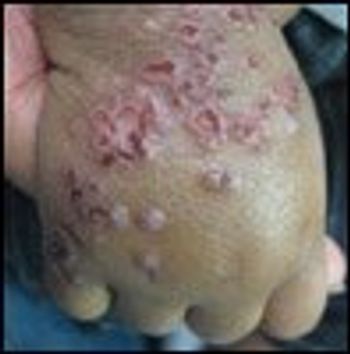
Investigators conducted a multicenter study of the effects of montelukast on eosinophil degranulation and recurrent wheezing episodes after respiratory syncytial virus bronchiolitis.

Investigators conducted a multicenter study of the effects of montelukast on eosinophil degranulation and recurrent wheezing episodes after respiratory syncytial virus bronchiolitis.

The nation knows little about why late pre-term births have increased and have driven up the overall preterm birth rate over the last several decades, an expert from CDC told Congress in a recent hearing.

While we can't predict the future, we may find clues to possible future developments in pediatric medicine based on changes that have occurred over the past two decades or so.

More than half of pediatricians report making a diagnostic error at least once or twice a month, a new study shows.

Children with newly diagnosed epilepsy generally have favorable outcomes, according to new research.

Being exposed to diabetes in utero substantially increases the risk of premature end-stage renal disease, according to a new study.

The FDA has released an alert for parents and caregivers regarding liquid Vitamin D supplement products.

The Office of the National Coordinator for Health Information Technology has issued a ruling that establishes a temporary certification program for EHR technology.

A new rule issued by FDA and authorized by the Family Smoking Prevention and Tobacco Control Act seeks to restrict the sale and distribution of cigarettes and smokeless tobacco to children and adolescents.

Vascular birthmarks are very common in newborns, and some varieties affect up to 50% of babies.

Mixing insulin detemir with aspart is equivalent to giving the 2 medications as separate injections in children with type 1 diabetes.

A 15-year-old girl is desperate for you to treat brown bumps on her chest, neck and trunk that have increased in number over the last 8 years.

Breast masses can cause anxiety for adolescent girls and their parents.

To help healthcare providers navigate through the language of HIT requirements in order to quality for EHR incentive payments, CMS has launched an official informational website for the Medicare and Medicaid incentive programs scheduled to begin in 2011.

The American College of Obstetricians and Gynecologists has issued a new committee opinion stating that the first dedicated reproductive health visit should take place when a girl is between 13 and 15 years.

A retraction pocket is to be differentiated from the common and usually benigh simple retracted tympanic membrane, which is often detected in a child with a simple upper respiratory infection.

After developing fever and left-sided lower back pain, a previously healthy 15-year-old boy had been diagnosed by his private physician with a urinary tract infection and treated with trimethorpim-sulfamethoxazole for 7 days.

FDA has authorized for use a new test for the diagnosis of H1N1 influenza virus infections. This test was developed by the CDC.

Investigators tested the hypothesis that analysis of gene expression of circulating white blood cells or of plasma cytokines can be used to improve diagnostic accuracy in children being evaluated for appendicitis.

FDA will now periodically prepare and post summaries of safety analyses on recently approved products as well as steps the agency is taking to address safety issues.

FDA has approved alglucosidase for patients aged 8 years and older for the treatment of late-onset Pompe disease.

On June 4, the Health Information Technology Policy Committee's meaningful use workgroup gave testimony on how to include in the definition of "meaningful use" measures that could reduce racial, ethnic or any other disparities in the health of patients.

With the recent and highly publicized tragedy involving a Delaware pediatrician arrested and charged with 471 criminal counts of sexual abuse of patients more than 12 years old, I believe we are all called on to examine our office practice of examination and anticipatory guidance.

Exposure to PCBs is associated with immunotoxic effects on serum concentration of specific antibodies against diphtheria and tetanus vaccinations, according to new research.

More than 50% of primary care physicians say that they are underprepared to diagnose and treat patients with bipolar disorder.

I read with interest Drs Ha and Wilson’s “What’s Your Diagnosis?” case of an infant with a history of wheezing and dry cough ("History of Cough in an Infant and a Toddler"). In a setting such as this, one should also consider the possibility of foreign-body aspiration, which can result in recurring wheezing and pneumonia.

Here: a "how to" on Gomco circumcision, the method most commonly used in the US.

Thoughts of my summer vacation are on the back burner now as I prepare to welcome the incoming pediatric residents. July 1st has a special meaning to all of us who have survived the grind of an internship. Fear was probably my main emotion at the start of my residency, while I’m sure for others it was excitement and anticipation. On July 8, I have to give a talk to the newcomers at our institution.

An 18-year-old boy presented with a several-month history of an intermittent, very pruritic rash on his back that did not improve with topical corticosteroids. Physical examination revealed grouped erythematous papules with a few scattered small vesicles on his posterior neck and bilateral posterior shoulders at the location where his backpack frequently rubbed.

A 1-year-old boy presented with a 10-day history of a nonpruritic rash that had persisted and spread despite treatment with a topical corticosteroid. Mother reported that he was febrile at the onset of the eruption; he was given over-the-counter antipyretics. On day 3, his pediatrician evaluated his condition and prescribed amoxicillin for his fever and hydrocortisone cream for his atopic dermatitis. Over the next several days, the fever subsided; however, the rash, which had started on the child’s right hand, persisted and spread to his face and elsewhere.